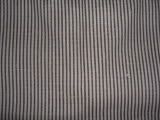Re: Material for shirt
Check out page 24 of Silver & Gold Cased Images of the California Gold Rush for an excellent example of pre-war hickory cloth.
Here is some linen hickory fabric I purchased specifically to reproduce this shirt (the stripes are an 1/8" wide):

Check out page 24 of Silver & Gold Cased Images of the California Gold Rush for an excellent example of pre-war hickory cloth.
Here is some linen hickory fabric I purchased specifically to reproduce this shirt (the stripes are an 1/8" wide):



Comment